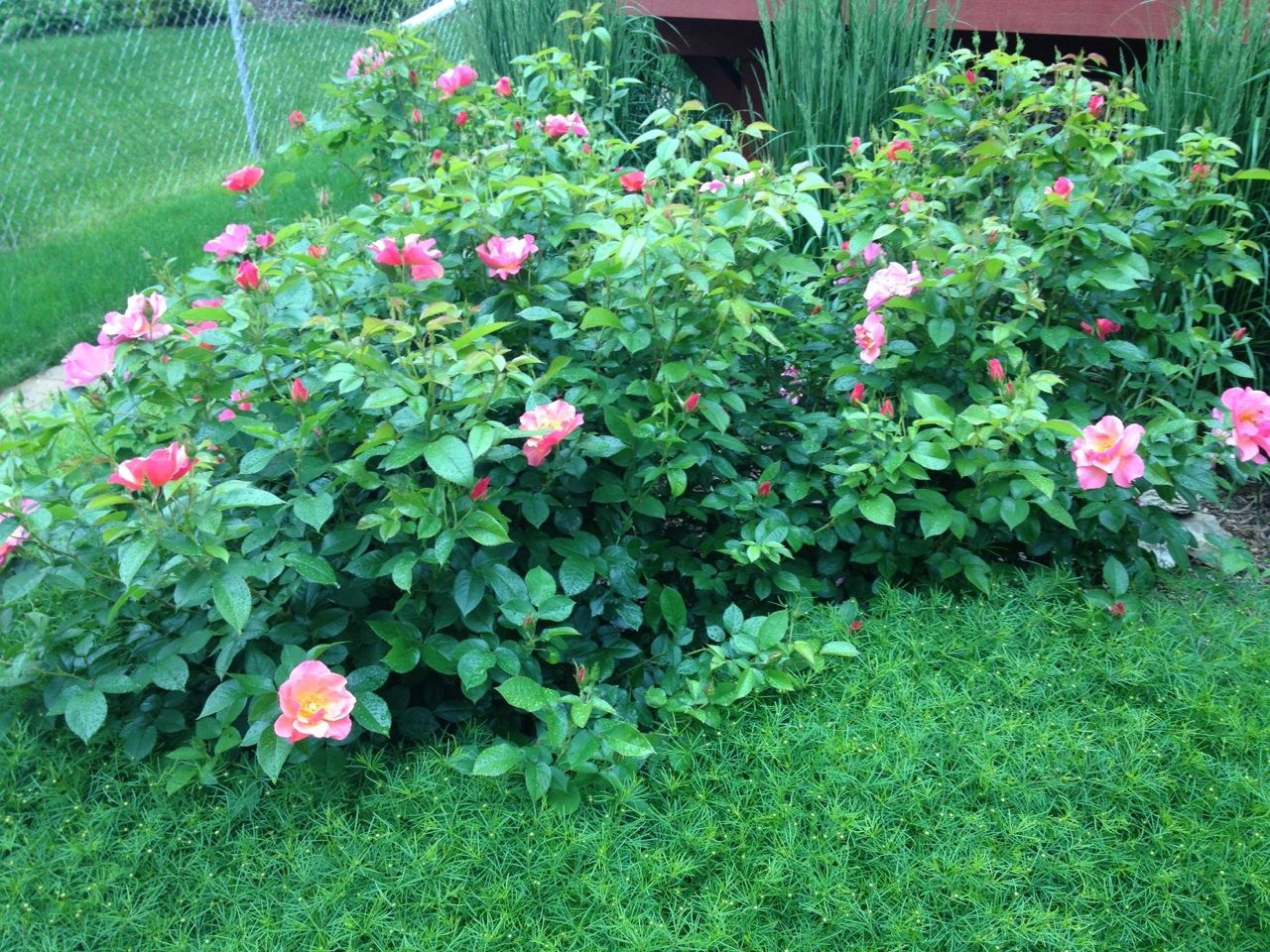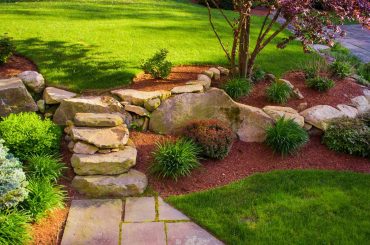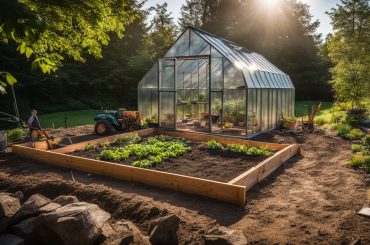Table of Contents
Imagine waking up to a garden or backyard full of a vibrant, bright and fragrant sea of flowers! Which is not just a dream but a delight to watch. Flowering shrubs are a great addition to your garden; most are not just easy to grow but also need much less of your time. With a vast range of colours, shapes and sizes, these colourful shrubs are just what you need.
But choosing the right shrub to elevate your garden can be overwhelming. In this blog, we will discuss 22 such colourful dwarf shrubs that will burst your garden with colours ranging from pink to bright red and light blues to deep purples.
Get ready to discover the perfect colours for your garden.
1. Heather
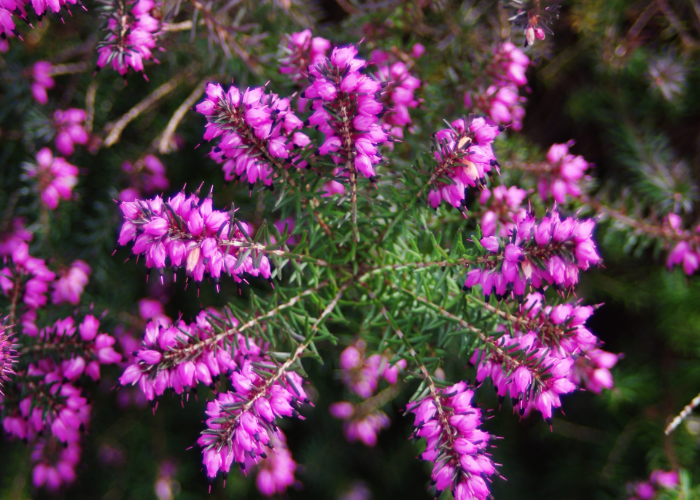
Calluna Vulgaris or commonly known as Heathers, belongs to the genus Erica. There are over 800 species; in the UK alone, there are around 400 species, and some of the heath flowers are scented. These are low-growing, hardy evergreen perennial shrubs with tiny upright and needle-like leaves. These flower colours range in colours like Pink, Purple, White, Orange and Yellow. If you like to have low-maintenance plants around, then these dwarf shrubs are what you need.
Heathers usually thrive in slightly acidic and dry soil under full sunlight. They need watering only in the first year of planting. After a year, they become drought-tolerant and may not need watering regularly. These dwarf shrubs grow up to 2 ft tall and 2 to 3 feet wide.
These compact shrubs are perfect for small gardens or pots. However, if you have a large garden, then Heathers are a beautiful choice for borders or ground covers, and the most interesting thing is that these shrubs are bee friendly.
Winter cold or summer heat, these cuties stand strong. As these are easy-growing plants, they do not need much attention with respect to fertilisers, Pruning and maintenance. But do check for pests occasionally, and do not let water clog around the plant.
2. Hebe
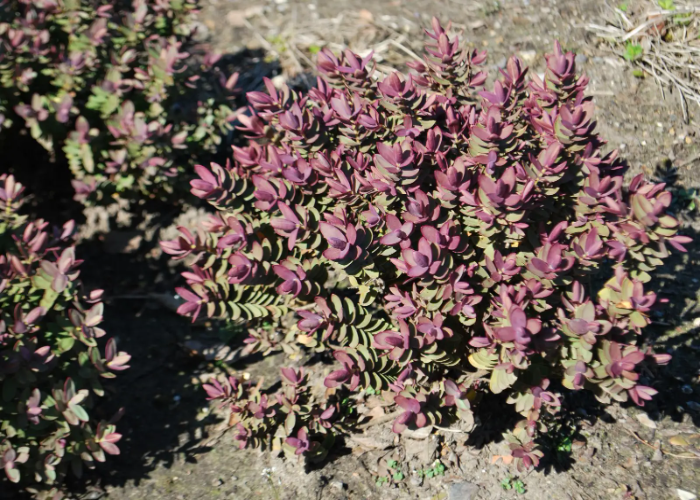
Hebe belongs to the genus Veronicas, which has 90- 100 species. These are bushy evergreen plants with ornamental leaves in green, maroon, blue-green and grey, with flowers in blue, purple and white. Hebes are easy to grow and care for plants; with their ability to withstand salt-laden, they are good to grow in coastal areas.
Hebes thrive in full sunlight and well-drained, moist and neutral acidic soil. These shrubs are known for their drought-tolerant nature; a weekly watering schedule can promote happy and healthy Hebe.
Hebes grow anywhere between 1 ft to 3ft and roughly up to 4 ft wide; it is important to prune the shrub to encourage blooming. Hebes usually bloom in Summer, Spring or Autumn and can live up to 5 to 10 years if cared for.
Not just the flowers but even the leaves make a beautiful and colourful border to your garden.
3. Weigela
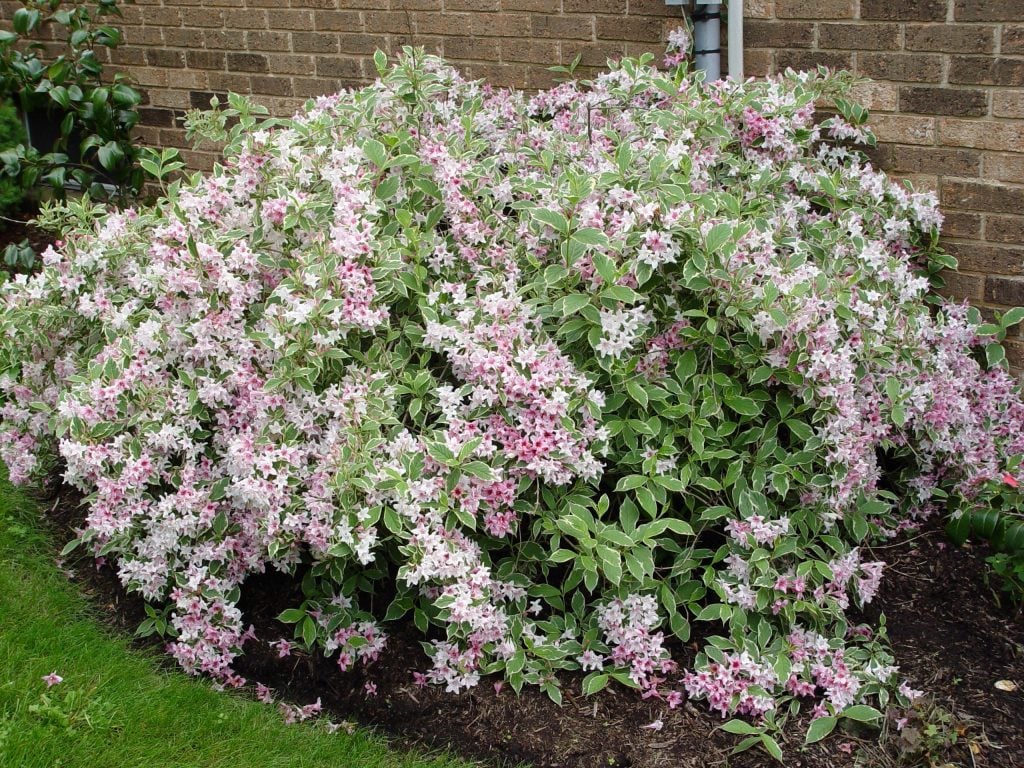
The Weigela genus belongs to the family of Caprifoliaceae, which has between 6 to 38 species. Do you know this genus is named after the German scientist Christina Ehrenfried Weigela?
They make exceptional foundational and commercial plants because of the bright flowers that range from pink to white and red.
These are hardy, low maintenance and easy-to-grow plants that can thrive in full sunlight to partial shade in dry, moist, well-drained soil. The best time to plant is between Oct- November. Weigela is slow-growing so one can expect flowers from May to July. Weigela grows between 1 ft to 3 ft and spreads between 18 – 71 inches.
If you choose to prune, mulch or fertilise, it is suggested to do after the flowering season, and it is advised to use organic fertilisers to avoid damage to the plants. These plants are usually disease free, but there are chances that they are prone to eelworms that feed on buds and leaves.
And the interesting fact is these plants attract hummingbirds and butterflies, which keeps your garden vibrant and lively.
4. Daphne
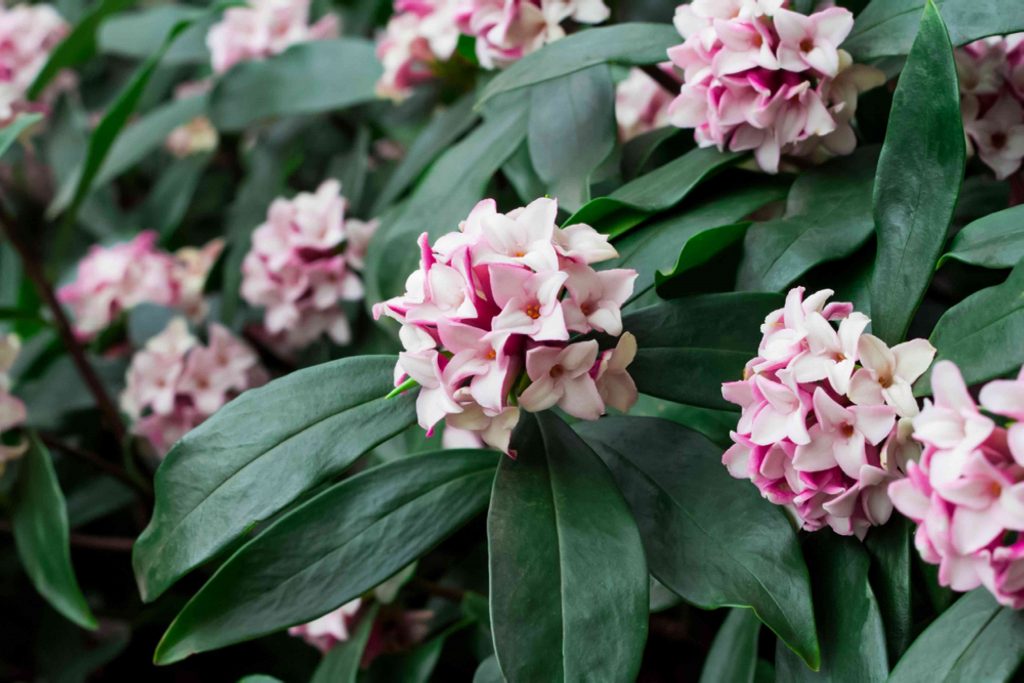
Daphne is a genus native to Asia, Europe, and South Africa and has around 90 species. These evergreen shrubs are known for their scented clustered flowers and bright-coloured berries.
These dwarf shrubs make good foundational plants and are a great choice for borders. These slow-growing plants are usually planted during Spring or early fall. But these plants are not easily grown; gardeners must pay attention to the soil to keep it moist and well-drained; these are also known for their sudden death without any reason. But these plants are easy to care for as they do not need Pruning or any special care.
These shrubs will do fine in full sunlight and slightly acidic soil. If you are transplanting a nursery-grown plant, make sure the soil is well-established. In the first year, this plant needs watering once a week; after that, try to maintain the soil and keep it moist alive. You can choose a mulching technique to help keep the moisture.
With the right balance in the soil, your Daphne will brighten up your garden, but it is noteworthy that Daphnes aren’t a great fan of Pruning.
Here’s a pro tip! The whole plant is considered toxic, especially the berries, so keep yourself safe and your fur babies away from this plant.
5. Ginny Gee
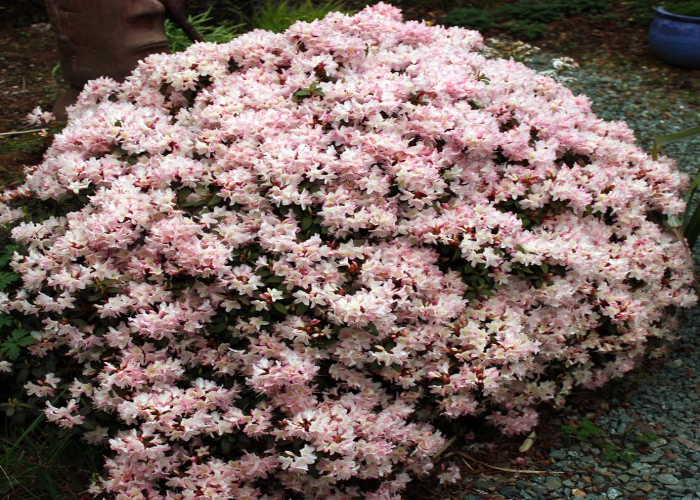
Ginny Gee belongs to the genus of Rhododendron and is a hardy evergreen dwarf flowering shrub with over 1000 species. These compact shrubs are known for their scented light pink flowers that are a great addition to your garden borders.
These plants usually thrive in full sunlight and partial shade in moist, well-drained, acidic soil. These plants have bushy and lush green foliage throughout the year and flowers in the spring season. These plants are relatively low maintenance as they do not need any special care after being established.
If you ever decide to prune these shrubs, do it after the flowering season and mulch annually to retain moisture and excessive weed growth. These dwarf shrubs grow up to 1.5 ft and are widespread up to 3 ft.
All parts of this shrub are considered toxic to humans and dogs, cats and horses when ingested. Do not forget to use protective equipment while handling the plant.
6. Daphne Cneorum
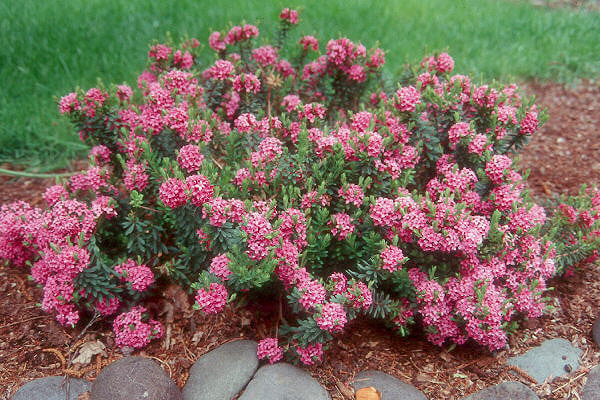
Daphne Cneorum, also known as Garland Flower, are native to Europe. These are evergreen shrubs with scented and clustered pink flowers. The flowering is so abundant that it smothers the plant. They are beautiful ornamental shrubs that are a perfect choice for borders, rock beds or along the pathway.
Garden Flowers usually thrive in full sunlight and partial shade and prefer moist, well-drained, neutral, alkaline soil. They have long and trailing evergreen leaves throughout the year and flowers only in Spring.
These plants resent transplanting, so try cultivating using semi-ripe cutting or grafting. Though they do not get infected by pests, mostly, they look for leaf spots. All parts of the plant are toxic; the sap can cause skin irritation.
Handling it with protective equipment on and keeping your pets away from it is recommended.
7. Dwarf Butterfly Bush
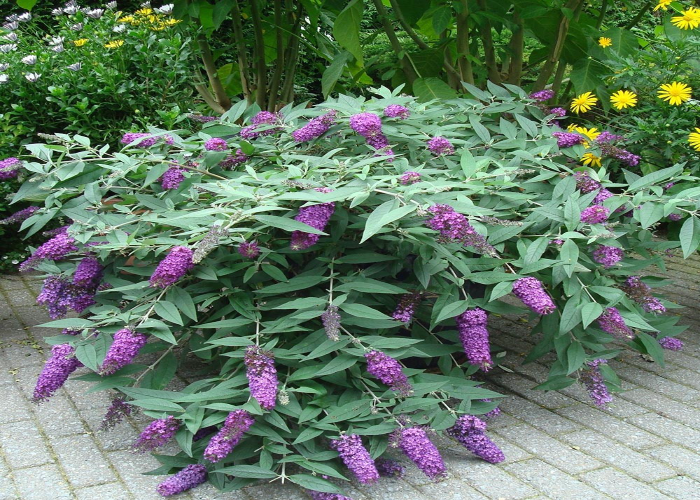
Dwarf Butterfly Bush belongs to Buddleja, which has over 100 species. This perennial has masses of tiny flowers ranging from purple, red, white and pink.
These dwarf bushes deserve a place in every garden with their splendid bloom and honey-scented flowers that make your garden look like heaven. These are easy to grow and are ideally planted in Spring, and usually flower in late summer. These plants thrive in sunlight in well-drained soil and need to be protected from winter frost.
These plants are low maintenance and do not need regular Pruning or mulching. But if you choose to do it, do it in early Spring and deadhead them after flowering. Buddlejas are generally problem-free, but they fail to grow in Winter due to root rot caused by water clogs. Dwarf butterfly bushes grow 2 ft in height and 3 ft wide, making them a perfect choice for the borders, and the fun fact is they attract insects and butterflies.
8. All Gold Shore Juniper
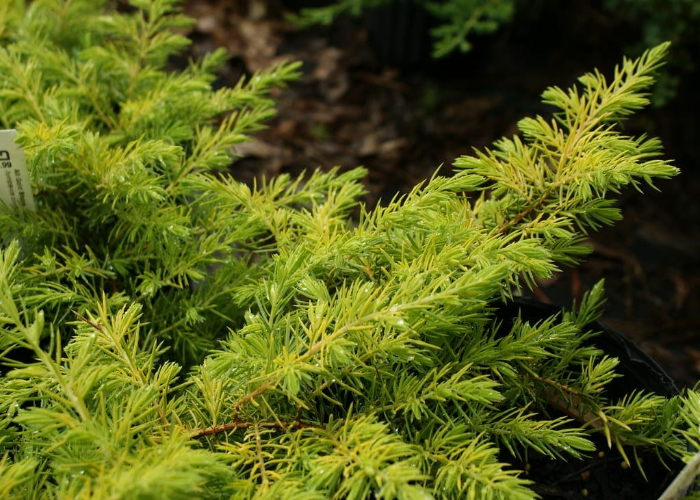
All Gold Shore Juniper, also known as Juniperus conferta “All gold”, is a Juniperus genus and Cupressaceae family cultivar. This slow-growing evergreen, well-spread shrub makes a great border for your large garden. The needle-like trailing leaves with golden-yellow foliage turn orange during Winter.
These shrubs are often used as groundcovers and rocky gardens or do great even in containers. Its drought-tolerant nature makes the plant grow in well-drained soil conditions and full sun. As a result, they are low-maintenance plants that do not need frequent watering and Pruning. If you want your shrub to not spread wide, prune the selective stems.
Shore Junipers do have white colour flowers, but they are not grown for their flowers as they are not that noticeable or showy cause the main attraction is the golden-yellow foliage. It grows up to 0.5 ft tall and 5ft wider.
9. Indoor Azalea
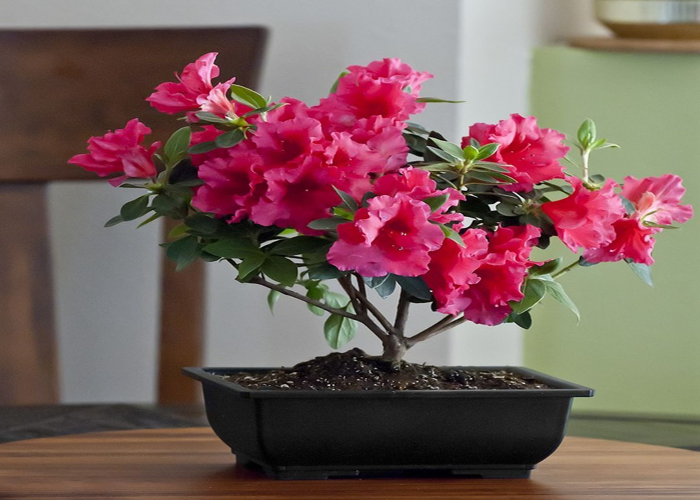
Rhododendron Indicum, commonly known as Indoor Azalea, is a species that belongs to Azalea. This is an evergreen flowering shrub which produces the most beautiful flowers in clusters of small flowers in the shades of pink, purple, red and white. These plants usually grow between 18 inches to 2 ft.
They are sensitive to frost areas and are best grown indoors in a pot. They thrive well in cool, humid temperatures with plenty of indirect light; there are chances of deterioration if exposed to dry and heat conditions. It blooms in Winter, and these flowers are best used during Christmas.
Make sure you provide organic compost and keep the soil moist all the time for a bountiful bloom. Keep an eye out for yellow spots and leaf drops for which the reason could be iron deficiency, hard water usage or dry conditions. During Spring or summer, these plants shed leaves, tension not; it is natural.
10. Winter Heath
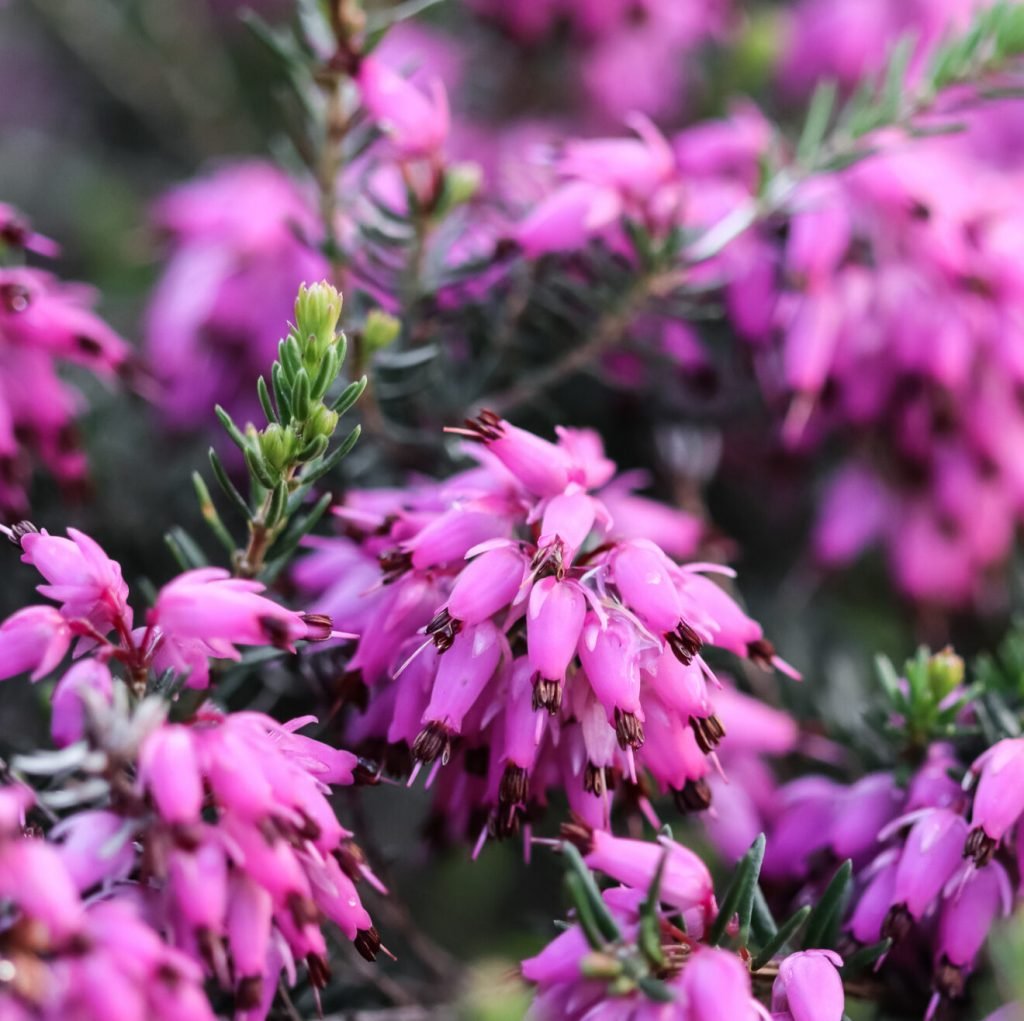
Erica Carnea, commonly known as Winter Heath, belongs to the genus Erica. These are low-growing evergreen flowering shrubs native to Mountain regions of Europe. These are also known as Spring Heath or Alpine Heath. Blooming heavily in early to late Winter, these plants make your garden look vibrant with bright-coloured flowers in pink and purple.
These low-maintenance plants are easy to grow as they are drought tolerant and can even sustain in colder weather. These plants perform better in full sun and well-drained, moist and acidic soils. Winter Heath dwarf shrub can grow up to 1 ft tall and 2 ft wide.
The plants are usually pests-free but do check for root rot, powdery mildew and wilt. These cool plants produce nectar which attracts bees. If you are looking for a garden with great visual impacts, then these plants are a perfect choice, as they make rock gardens and ground covers and can grow in containers too.
11. Dwarf Japanese Pieris Shrub
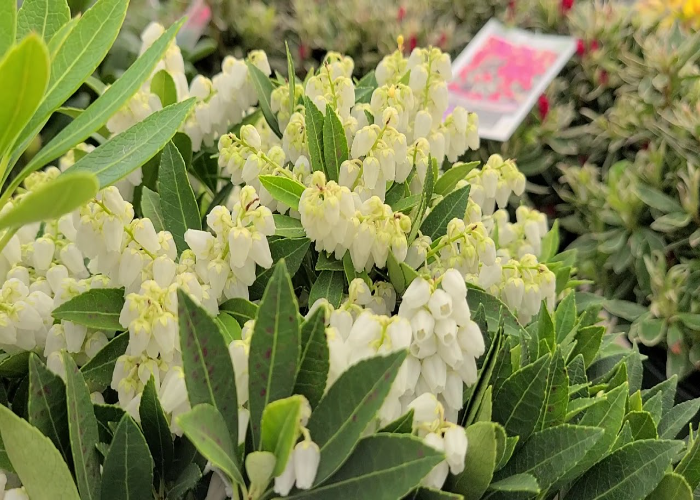
Japanese Pieris, also known as Japanese andromeda or dwarf lily-of-the-valley shrub, belongs to the genus Pieris and the Heath family Ericaceae. This compact evergreen shrub is an easy-to-grow, easy-to-care plant with colourful leaves and flowers.
The flowers appear pink and white, with red leaves and these urn-shaped flowers. These plants make a beautiful addition to your garden. The blooming starts early in Spring and lasts 2 to 3 weeks.
The plants grow in partial shade with well-drained, moist soil well-equipped with organic compost and need regular watering during dry spells. Mulching and Pruning promote healthy growth and retain moisture.
These plants grow up to 2 ft tall and 4 ft spread. The most important and noteworthy thing is the toxicity of the leaves and flowers. Animals also might end up vomiting, cardiac arrest and death if ingested. Be careful while handling!
12. Dwarf Chenille
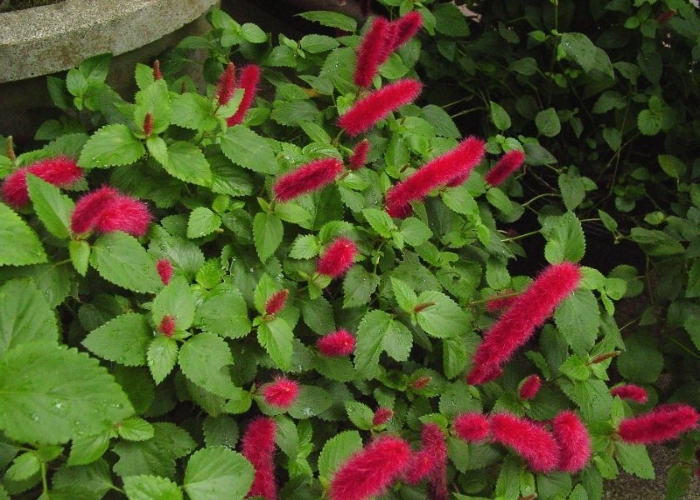
Acalypha Pendula, commonly known as Dwarf Chenille, is a compact bush with trailing leaves. These plants are known for their crimson spiky, needle-like flowers that can stand upright up to 7cm long.
With its dark and exotic foliage, these plants make excellent indoor plants that can grow in containers, hanging baskets or as annuals. They can thrive in full sunlight to partial shade in humus-rich, well-drained, moist soil. If grown inside, keep the plant in filtered light.
During the growing season, use liquid fertilisers and water freely. Deadhead and prune before flowering to stimulate rebloom. Dwarf Chenille grow up to 2 feet high and 2 ft wide. This makes a perfect addition to your garden as they flower throughout the year and resemble red fluffy, cylindrical caterpillars.
13. Blue Beard Bush
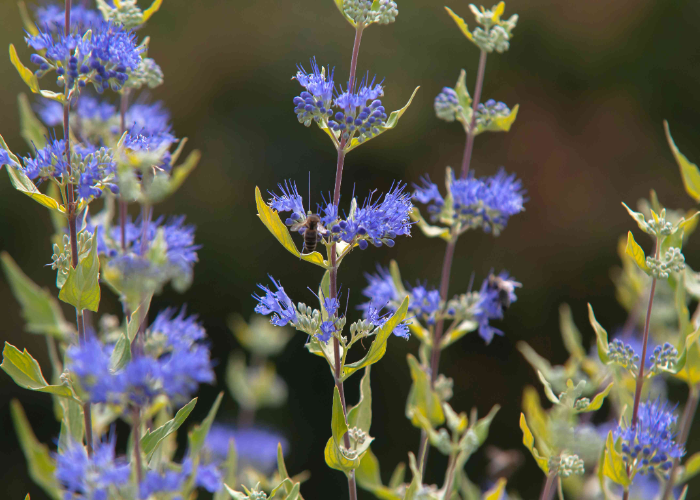
Caryopteris x clandonensis, commonly known as Blue Beard or Blush Mist, belongs to the family of Lamiaceae. This is a compact deciduous shrub with aromatic leaves and profuse flowers ranging in colours from Blue, Purple and Pink.
This low maintenance drought tolerant shrub can thrive and bloom in full sun in average moist and well-drained acidic soil. These shrubs are a perfect choice for borders, low hedges and containers.
Once established, they will grow for 30 years and can grow up to 2 ft tall. Usually, they flower from late summer through early fall. As they attract butterflies, bees and some useful insects, they make a great choice to make your garden vibrant and beautiful. Not just that Bluebeard leaves are used as a disinfectant; they are applied on wounds, burns, ulcers, soars and mosquito repellent too.
14. Dwarf Fothergilla
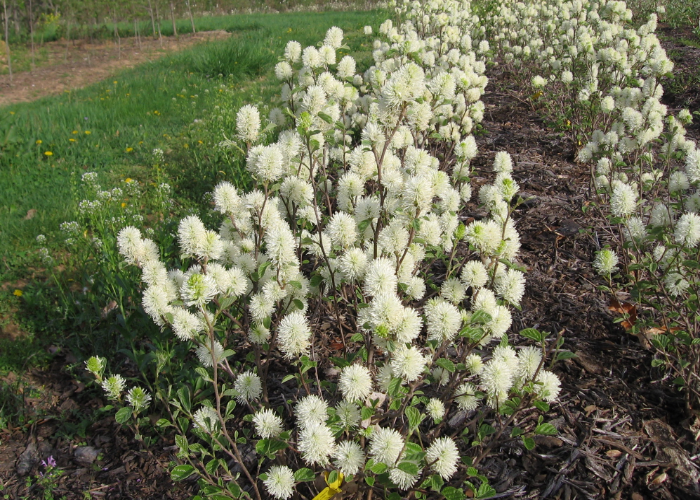
Fothergilla gardenii, also known as witch alder, Dwarf Fothergilla, belongs to the genus Fothergilla and the Hamamelidaceae family. This is a slow-growing deciduous shrub with showy flowers and leaves. The leaves turn golden yellow, orange to red, all colours on the same leaf in fall. The honey-scented upright creamy white bottle brush-like flowers are 2 inches long.
These are low-maintenance plants that can thrive in full sun and can grow in moist, well-drained, rich, acidic soil. They bloom well in full exposure to sunlight and bloom in Spring. Usually, these plants are pest and disease free. Dwarf Fothergilla can make great foundational plantings and rain gardens and can typically grow up to 2 ft tall.
15. Dwarf Lavender
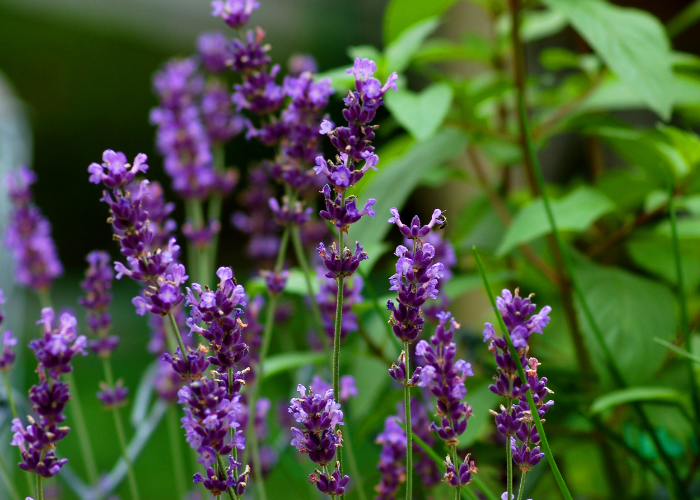
Lavandula angustifolia, or Little Lady, is a dwarf compact lavender known for its aromatic and beautiful flowers, making it suitable for pathways, garden borders or even indoor plants.
Low-maintenance plants can thrive in full sunlight, and their ability to tolerate droughts makes them flexible to grow even in non-fertile soils. They usually bloom in late Spring to early summer, extending from 3 to 4 weeks.
These plants grow up to 1 ft when mature and 1 ft wide. These plants attract butterflies and bees and are good-cut flowers. If you are looking for an aromatic purple garden with butterflies and bees, bulk-planting these little ladies is a great idea.
16. Minuet Mountain Laurel
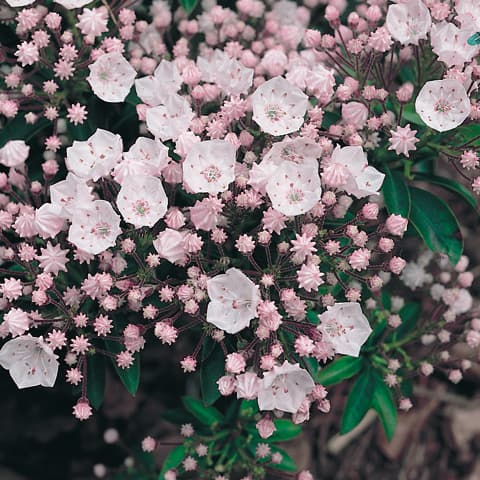
Kalmia latifolia, commonly known as Minute, is a compact evergreen shrub with glossy, lush green leaves and beautiful white flowers with dark red bands circling.
These plants prefer to grow in moist, well-drained, acidic soil and thrive in full sunlight or partial shade. These plants grow 1.5 ft tall and spread 3 ft wide. They usually flower in Spring and summer.
Usually, all parts of the plant are considered toxic if ingested, do not forget to put in those garden gloves while handling it.
17. California Lilac
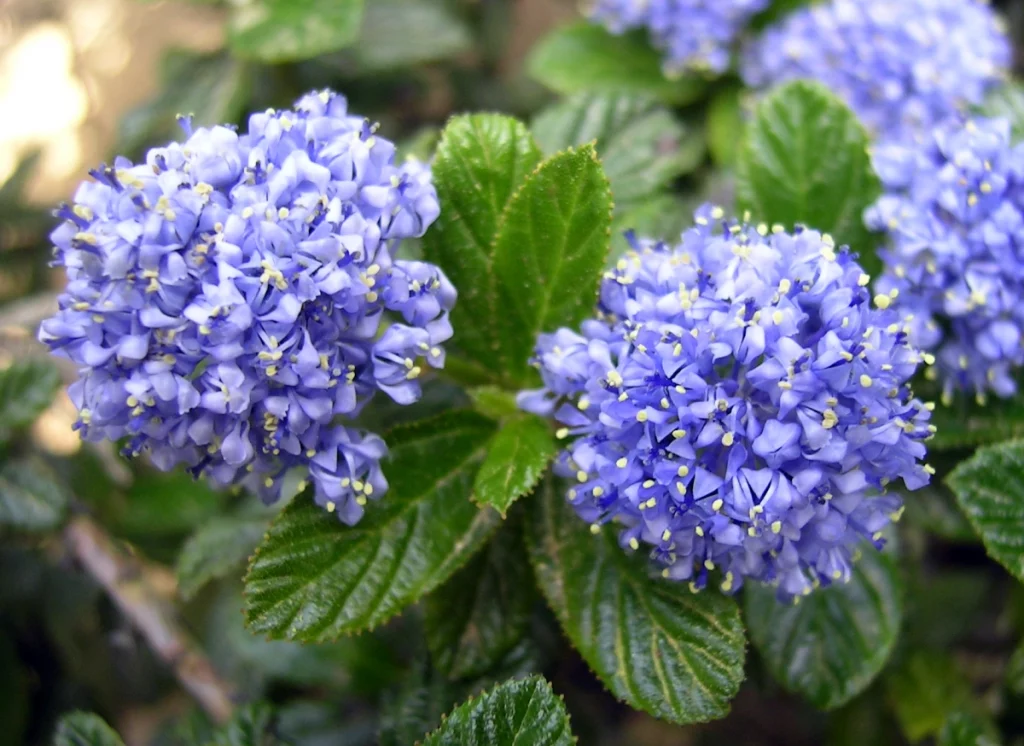
Ceanothus Divergence, also known as California Lilac, is a genus of flowering shrub with about 50 – 60 species and belongs to the family of buckthorns.
This is a dwarf variety which is a low-growing compact evergreen shrub with dense leaves. This plant is well known for its nitrogen fixation nature and beautiful, sweetly fragrant purple shade clusters of small flowers. These plants usually bloom from early Spring to Winter; depending upon the variety, the blooming season varies.
Due to its wild nature, these plants thrive on neglect. In the first year, it needs to be watered regularly, but once it is established, it requires watering once or twice a month. They are used as showy, cut, and aromatic flowers in soaps and shampoos in tribal areas. They usually grow around 1.6 ft once matured and 5 ft wide.
18. Bush Honeysuckle
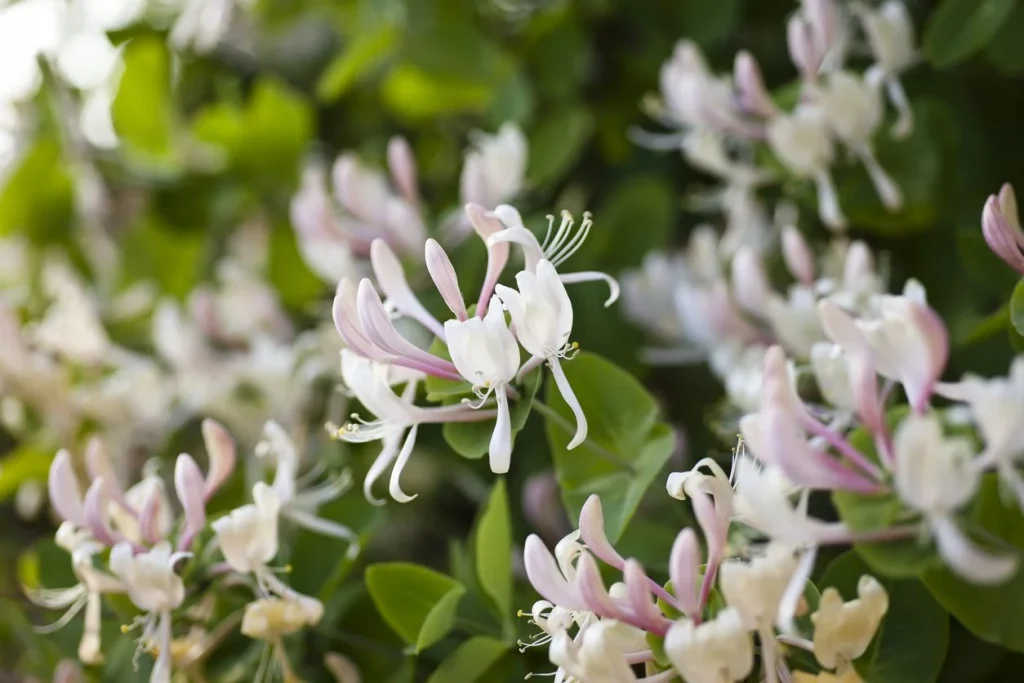
Diervilla Lonicera, or Bush Honeysuckle, is a utility shrub with bronze leaves and small yellow flowers.
This plant usually blooms in early summer and is known for its ornamental leaves, which emerge in different colours during different seasons. This shrub does well in full sunlight and adapts to various soils.
These plants are grown in terrain areas to help stabilise soil and erosion. This is the perfect choice for urban gardens as they do not need any attention and can easily thrive in city pollution too.
19. Lydian Broom
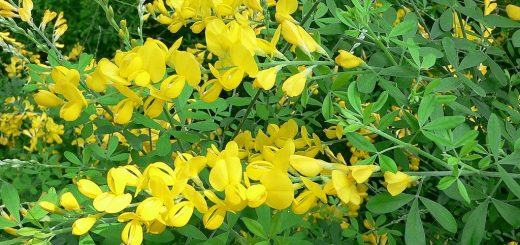
Genista Lydia Bangle or Lydian Broom is the perfect option for the lustrous yellow bloom and arching leaves, which will be a showstopper.
These showy plants are easy to grow and low maintenance, making them adaptable to all soil types and full sun exposure. They usually bloom in late Spring and early summer, grow between 1 – 2 ft, and can spread up to 2 ft wide.
Pruning after the flowering season promotes more branches and brings a great look to the shrub.
20. Crown Jewel
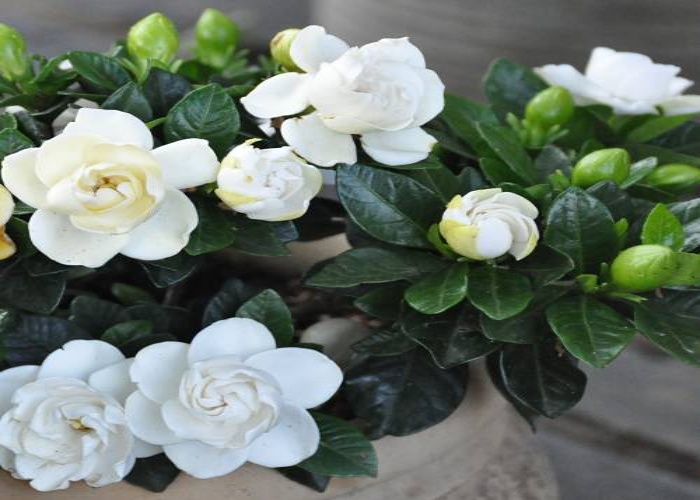
Gardenia jasminoides, or Crown Jewel, is a hardy evergreen flowering shrub. The thick, hard and lustrous green leaves with intense fragrant double white colour flowers make this shrub a beautiful addition to your garden.
This compact shrub grows up to 2 ft tall and blooms twice a year, and its ability to withstand colder conditions and profuse flowering makes this a perfect garden and container shrub.
Though they can thrive in full sunlight and partial shade, they cannot survive in severe hot climates, which leaves the leaves scorched mulch in Winter with an organic layer to retain moisture when exposed to full sunlight. Prune and deadhead to encourage new bloom.
These plants are prone to pests and diseases, so check for powdery mildew, leaf spots, aphids, spider mites etc. It is not worth that it is toxic to dogs, cats and horses, so keep your pets away.
21. Miniature Teacup Roses
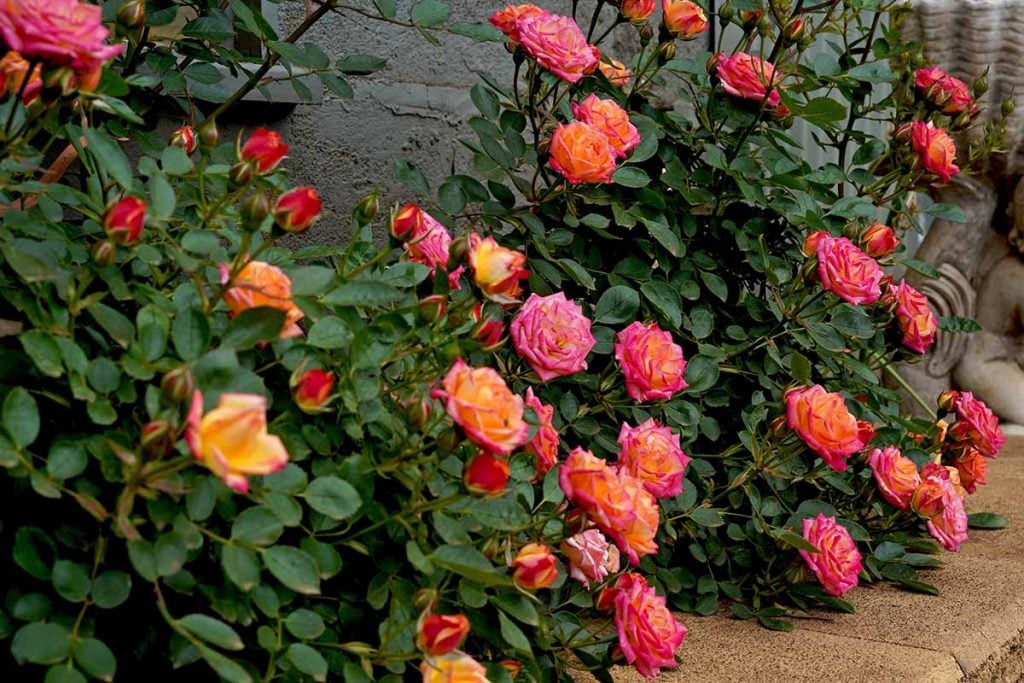
Miniature roses are real roses bred specially to stay small and grow in containers.
They grow up to 2 ft tall and 2 ft wide and are highly hardy plants that can thrive in extreme winter conditions and full sunlight in moist and well-drained soil. They usually bloom in Spring and summer. Due to their small root size, they need frequent deep watering, even on alternate days or just twice a week.
As we know, roses are heavy feeders; fertilise regularly to encourage healthy bloom and do not forget to prune just before the bloom. Unfortunately, miniature roses are prone to mildew, and leaf spots maintain well-aerated and well-drained soil and plant the bushes a few feet apart.
22.Low Scape Mound
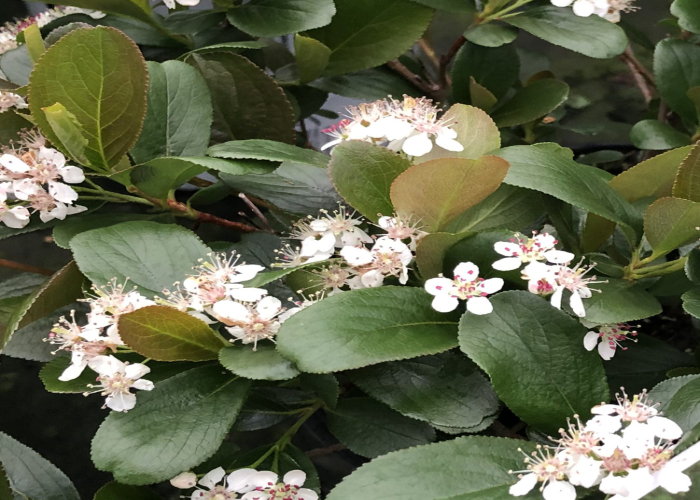
Aronia melanocarpa, a low-scale mound, is a low-growing flowering shrub with black chokeberries. It is a tough, hardy shrub with glossy green foliage. It blooms in Spring with hundreds of white flowers, which turn red in autumn.
This low-maintenance and easy-growing shrub thrives in colder and hotter climates, making it a perfect choice for bulk planting. These form great borders for your garden.
These shrubs grow between 1 ft to 2 ft and spread to 2 ft wide. The interesting nature of mounding without deadheading or pruning makes it a choice for ground covers, borders, mass planting and landscaping.
Conclusion
Flowering Shrubs add a pop to your garden and a vibrant life to your whole house. With excellent care and attention, most flowering shrubs provide a beautiful scenic view of the garden. From profuse flowering to long-lasting blooming, there are a wide variety of shrubs. Whether you like bright colours or subdued hues, there is every shrub for your taste. These 22 colourful flowering shrubs we have discussed will give you information about the shrubs that will suit your needs.
By following the tips outlined in the blog, you can create a beautiful and lively garden with butterflies and bees. Whether you are a seasoned gardener or a beginner, this blog will help you choose the perfect and unique shrubs under 2 ft in height that are both low maintenance and easy to grow.
So, why not add a splash of colour to your garden with these shrubs?

